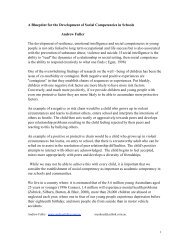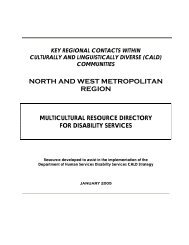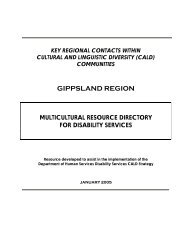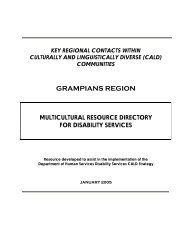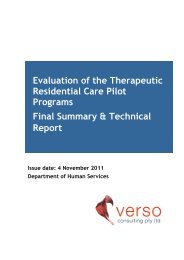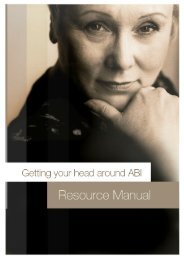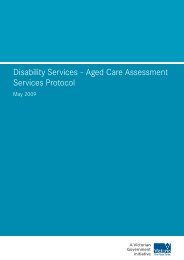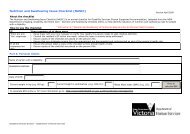Positive Behaviour Support - Department of Human Services - Vic ...
Positive Behaviour Support - Department of Human Services - Vic ...
Positive Behaviour Support - Department of Human Services - Vic ...
You also want an ePaper? Increase the reach of your titles
YUMPU automatically turns print PDFs into web optimized ePapers that Google loves.
74 <strong>Positive</strong> behaviour support: Getting it right from the start - Facilitators reference manual<br />
PowerPoint 100*<br />
Changing background factors<br />
Possible background factors Changes<br />
Personal<br />
The person appears to no longer be able to do the<br />
things they once could<br />
The person has a urinary tract infection Medical treatment<br />
The person has been on high doses <strong>of</strong> psychotropic<br />
medication for over three years<br />
The person has a large appetite and only gets to eat at<br />
main meal times<br />
The person does not see other people as a source <strong>of</strong><br />
enjoyment ( based on many failed experiences and<br />
much criticism in the past)<br />
Person is non-speaking and has no communication<br />
skills<br />
Person has recently began to head bang, withdraw<br />
from others and avoid eye contact<br />
Person’s methods <strong>of</strong> communication are hard to<br />
understand<br />
Environmental<br />
Document skills the person can no longer do<br />
and discuss with the medical practitioner<br />
Refer to psychiatrist for a medication review<br />
Provide the person with nutritious meals through<br />
the day<br />
Build rapport with the person by <strong>of</strong>fering things<br />
that they like<br />
Complete a checklist <strong>of</strong> communication<br />
competencies to identify person’s level <strong>of</strong><br />
communication<br />
Document new behaviours and discuss with<br />
medical practitioner<br />
Complete a personal communication dictionary<br />
The person has few opportunities to exercise choice Increase the number <strong>of</strong> choices available to the<br />
person<br />
Staff have low expectations <strong>of</strong> what can do and so<br />
don’t provide her with many opportunities<br />
The person lives in an overcrowded and unstimulating<br />
house<br />
The BSP does not focus on positive behaviour support<br />
strategies and instead focussed on the restrictive<br />
interventions<br />
Provide training to staff on recognising the<br />
strengths <strong>of</strong> service users, and then get them to<br />
build a strength list for the person<br />
Improving the person’s accommodation by<br />
internal modifications, or by adding a flat and<br />
fitting it out with materials <strong>of</strong> the person’s<br />
choosing<br />
A functional behaviour assessment needs to<br />
be completed to identify the functions <strong>of</strong> the<br />
behaviour<br />
A combination <strong>of</strong> environmental strategies and<br />
skills development strategies are put in place<br />
The person does not interact with others much Increase the number <strong>of</strong> interactions the person<br />
has with others by encouraging a hobby which<br />
will act as a springboard for interaction<br />
The atmosphere in the person’s support service is<br />
tense because <strong>of</strong> simmering disputes between staff<br />
There is a lack <strong>of</strong> predictability in the activities <strong>of</strong> the<br />
day from the person’s point <strong>of</strong> view<br />
Introduce a grievance process<br />
Introduce an activity sequence chart



